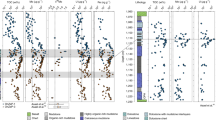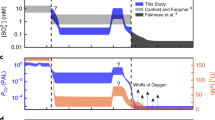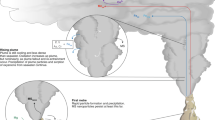Abstract
SUSPENDED participate samples collected from the TAG hydrothermal vent field, at 26° N on the Mid-Atlantic Ridge, contain ˜10% of the total rare-earth element content (by volume) of ambient sea water. Shale-normalized distribution patterns show both positive europium anomalies and negative cerium anomalies, indicating that the rare-earth elements in these hydrothermal precipitates come from both hydrothermal vent fluid and seawater sources. Rare-earth/Fe concentration ratios in the suspended p articulate material increase at increasing distances from their hydro-thermal source, indicating that rare-earth elements must be continuously extracted from sea water as hydrothermal precipitates are dispersed through the water column. Therefore, although high-temperature vent fluids escaping from the sea floor are typically enriched 10–10,000 times in rare-earth elements relative to sea water1–4, hydrothermal systems must nevertheless act as a net sink in the global ocean budget of the rare-earth elements. But as the maximum rare-earth/Fe ratios observed for suspended particles are ˜10 times lower than previously reported values for hydrothermal sediments5–8, it seems that most of the uptake of rare-earth elements from sea water must occur only after hydrothermal precipitates have settled to the underlying sediments.
This is a preview of subscription content, access via your institution
Access options
Subscribe to this journal
Receive 51 print issues and online access
$199.00 per year
only $3.90 per issue
Buy this article
- Purchase on Springer Link
- Instant access to full article PDF
Prices may be subject to local taxes which are calculated during checkout
Similar content being viewed by others
References
Michard, A. et al. Nature 303, 795–797 (1983).
Michard, A. & Albarede, F. Chem. Geol. 55, 51–60 (1986).
Hinkley, T. K. & Tatsumoto, M. J. geophys. Res. 92, 1943–1959 (1987).
Campbell, A. C. et al. Nature 335, 514–519 (1988).
Bender, M. et al. Earth planet. Sci. Lett. 12, 425–433 (1971).
Ruhlin, D. E. & Owen, R. M. Geochim. cosmochim. Acta 50, 393–400 (1986).
Owen, R. M. & Olivarez, A. M. Mar. Chem. 25, 183–196 (1988).
Olivarez, A. M. & Owen, R. M. Geochim. cosmochim. Acta 53, 757–762 (1989).
Dymond, J. & Roth, S. Geochim. cosmochim. Acta 52, 2525–2536 (1988).
Bertram, C. J., thesis, Univ. Cambridge (1989).
Haskin, M. A. & Haskin, L. A. Science 154, 507–509 (1966).
Klinkhammer, G., Elderfield, H. & Hudson, A. Nature 305, 185–188 (1983).
Trocine, R. P. & Trefry, J. H. Earth planet. Sci. Lett. 88, 1–15 (1988).
Feely, R. A. et al. Earth planet. Sci. Lett. 96, 305–318 (1990).
Trefry, J. H. & Metz, S. Nature 342, 531–533 (1989).
German, C. R. et al. Eos 70, 1164 (1989).
Author information
Authors and Affiliations
Rights and permissions
About this article
Cite this article
German, C., Klinkhammer, G., Edmond, J. et al. Hydrothermal scavenging of rare-earth elements in the ocean. Nature 345, 516–518 (1990). https://doi.org/10.1038/345516a0
Received:
Accepted:
Issue Date:
DOI: https://doi.org/10.1038/345516a0
This article is cited by
-
Integrated petrographical and geochemical study of the Valanginian–Barremian carbonates: an appraisal of tectonic setting and depositional environment in Northeastern Iraq
Carbonates and Evaporites (2023)
-
Rare earth elements in sediments of the Pearl River Estuary, China: distribution, influencing factors, and multi-index assessment
Journal of Soils and Sediments (2023)
-
The boundary between the Inthanon Zone (Palaeotropics) and the Gondwana-derived Sibumasu Terrane, northwest Thailand—evidence from Permo-Triassic limestones and cherts
Palaeobiodiversity and Palaeoenvironments (2022)
-
Characteristics of rare earth elements in the surface sediments of Southwest Indian Ridge: implication of grain size for the identification of hydrothermal activity
Geo-Marine Letters (2022)
-
Rapid coupling between solid earth and ice volume during the Quaternary
Scientific Reports (2021)
Comments
By submitting a comment you agree to abide by our Terms and Community Guidelines. If you find something abusive or that does not comply with our terms or guidelines please flag it as inappropriate.



